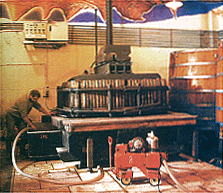
Fermentation |
Press, settle and rack
wine
 1. Move pomace to
press as gently as possible. Bitter/harsh character is extracted from macerated
skins (not necessarily skin tannins).
1. Move pomace to
press as gently as possible. Bitter/harsh character is extracted from macerated
skins (not necessarily skin tannins).
2.
Drain and press directly to the tank with quality oak integration system. Or
settle, then rack into the tank with quality oak integration system.
3. Rack or micro oxygenate just enough to
control sulfides until malolactic fermentation has completed. (Do not
add copper after any aerative procedure).
Gently moving drained pomace
usually produces a higher percentage of press wine that may be used later,
without it adding overtly harsh phenolic tastes. It is commonly believed that
grinding skins enhances the extraction of skin tannins, thereby producing
excessive harshness.
However, recent research by Dr
Véronique Cheynier, Directeur de Recherches, Institut National de la
Recherche Agronomique in Montpellier (INRA), and Elizabeth Waters at the
Australian Wine Research Institute (AWRI), have shown this common belief is not
accurate. They isolated fractions of skin and seed tannins of average lengths:
degree of polymerization (dp) 3, 7 and 15. Sensory evaluation of these
fractions by Leigh Francis at AWRI has shown that none of these tannin
fractions are bitter. As predicted, they do increase astringency as the polymer
size increases, proving that skin tannins are not responsible for the
bitterness and harshness in the press fraction of wines. However, there are
many other phenolic based compounds which could be responsible (research
continuing).
Copper additions to wine should only be made with
forethought! For copper to act as we expect it to, it binds with free thiols or
mercaptans and must be added to wine at low redox potentials (reduced
conditions). If copper is added too soon after an aerative process, e.g.
racking, it will act as a catalyst to form disulfides rather than bind the free
thiols or mercaptans. If disulfides are formed, free thiols may reappear later
in the life of that wine. |
|
|
|







